Pierre-Auguste Renoir
| Pierre-Auguste Renoir | |
|---|---|
 | |
| Born |
25 February 1841 Limoges, Haute-Vienne, France |
| Died |
3 December 1919 (aged 78) Cagnes-sur-Mer, Provence-Alpes-Côte d'Azur, France |
| Nationality | French |
| Known for | Painting |
| Notable work |
Bal du moulin de la Galette, 1876 Luncheon of the Boating Party, 1880 Nude, 1910 |
| Movement | Impressionism |
Pierre-Auguste Renoir, commonly known as Auguste Renoir (US /rɛnˈwɑːr/ or UK /ˈrɛnwɑːr/; French: [pjɛʁ oɡyst ʁənwaʁ]; 25 February 1841 – 3 December 1919), was a French artist who was a leading painter in the development of the Impressionist style. As a celebrator of beauty, and especially feminine sensuality, it has been said that "Renoir is the final representative of a tradition which runs directly from Rubens to Watteau."[1]
He was the father of actor Pierre Renoir (1885–1952), filmmaker Jean Renoir (1894–1979) and ceramic artist Claude Renoir (1901–1969). He was the grandfather of the filmmaker Claude Renoir (1913–1993), son of Pierre.
Youth
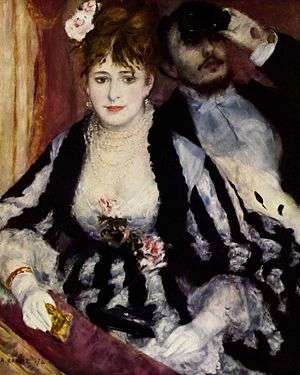
Pierre-Auguste Renoir was born in Limoges, Haute-Vienne, France, in 1841. His father, Léonard Renoir, was a tailor of modest means, so in 1844, Renoir's family moved to Paris in search of more favorable prospects. The location of their home, in rue d’Argenteuil in central Paris, placed Renoir in proximity to the Louvre. Although the young Renoir had a natural proclivity for drawing, he exhibited a greater talent for singing. His talent was encouraged by his teacher, Charles Gounod, who was the choir-master at the Church of St Roch at the time. However, due to the family’s financial circumstances, Renoir had to discontinue his music lessons and leave school at the age of thirteen to pursue an apprenticeship at a porcelain factory.[2][3]
Although Renoir displayed a talent for his work, he frequently tired of the subject matter and sought refuge in the galleries of the Louvre. The owner of the factory recognized his apprentice’s talent, and communicated this to Renoir’s family. Following this, Renoir started taking lessons to prepare for entry into Ecole des Beaux Arts. When the porcelain factory adopted mechanical reproduction processes in 1858, Renoir was forced to find other means to support his learning.[3] Before he enrolled in art school, he also painted hangings for overseas missionaries and decorations on fans.[4]
In 1862, he began studying art under Charles Gleyre in Paris. There he met Alfred Sisley, Frédéric Bazille, and Claude Monet.[5] At times, during the 1860s, he did not have enough money to buy paint. Renoir had his first success at the Salon of 1868 with his painting Lise with a Parasol (1867), which depicted Lise Tréhot, his lover at the time.[6] Although Renoir first started exhibiting paintings at the Paris Salon in 1864,[7] recognition was slow in coming, partly as a result of the turmoil of the Franco-Prussian War.
During the Paris Commune in 1871, while Renoir painted on the banks of the Seine River, some Communards thought he was a spy and were about to throw him into the river, when a leader of the Commune, Raoul Rigault, recognized Renoir as the man who had protected him on an earlier occasion.[8]
In 1874, a ten-year friendship with Jules Le Cœur and his family ended,[9] and Renoir lost not only the valuable support gained by the association, but also a generous welcome to stay on their property near Fontainebleau and its scenic forest. This loss of a favorite painting location resulted in a distinct change of subjects.
Adulthood


Renoir was inspired by the style and subject matter of previous modern painters Camille Pissarro and Edouard Manet.[10] After a series of rejections by the Salon juries, he joined forces with Monet, Sisley, Pissarro, and several other artists to mount the first Impressionist exhibition in April 1874, in which Renoir displayed six paintings. Although the critical response to the exhibition was largely unfavorable, Renoir's work was comparatively well received.[6] That same year, two of his works were shown with Durand-Ruel in London.[9]
Hoping to secure a livelihood by attracting portrait commissions, Renoir displayed mostly portraits at the second Impressionist exhibition in 1876.[11] He contributed a more diverse range of paintings the next year when the group presented its third exhibition; they included Dance at Le Moulin de la Galette and The Swing.[11] Renoir did not exhibit in the fourth or fifth Impressionist exhibitions, and instead resumed submitting his works to the Salon. By the end of the 1870s, particularly after the success of his painting Mme Charpentier and her Children (1878) at the Salon of 1879, Renoir was a successful and fashionable painter.[6]
In 1881, he traveled to Algeria, a country he associated with Eugène Delacroix,[12] then to Madrid, to see the work of Diego Velázquez. Following that, he traveled to Italy to see Titian's masterpieces in Florence and the paintings of Raphael in Rome. On 15 January 1882 Renoir met the composer Richard Wagner at his home in Palermo, Sicily. Renoir painted Wagner's portrait in just thirty-five minutes. In the same year, after contracting pneumonia which permanently damaged his respiratory system, Renoir convalesced for six weeks in Algeria.[13]
In 1883, Renoir spent the summer in Guernsey, one of the islands in the English Channel with a varied landscape of beaches, cliffs and bays, where he created fifteen paintings in little over a month. Most of these feature Moulin Huet, a bay in Saint Martin's, Guernsey. These paintings were the subject of a set of commemorative postage stamps issued by the Bailiwick of Guernsey in 1983.
While living and working in Montmartre, Renoir employed Suzanne Valadon as a model, who posed for him (The Large Bathers, 1884–87; Dance at Bougival, 1883)[14] and many of his fellow painters; during that time she studied their techniques and eventually became one of the leading painters of the day.
In 1887, the year when Queen Victoria celebrated her Golden Jubilee, and upon the request of the queen's associate, Phillip Richbourg, Renoir donated several paintings to the "French Impressionist Paintings" catalog as a token of his loyalty.
In 1890, he married Aline Victorine Charigot, who, along with a number of the artist's friends, had already served as a model for Le Déjeuner des canotiers (Luncheon of the Boating Party – she is the woman on the left playing with the dog) in 1881, and with whom he had already had a child, Pierre, in 1885.[13] After his marriage, Renoir painted many scenes of his wife and daily family life including their children and their nurse, Aline's cousin Gabrielle Renard. The Renoirs had three sons: Jean Renoir, who became a filmmaker of note, Pierre Renoir, who became a stage and film actor, and Claude Renoir, who became a ceramic artist.
Later years
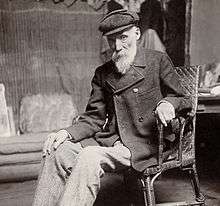
Around 1892, Renoir developed rheumatoid arthritis. In 1907, he moved to the warmer climate of "Les Collettes," a farm at Cagnes-sur-Mer, close to the Mediterranean coast.[15] Renoir painted during the last twenty years of his life even after his arthritis severely limited his mobility. He developed progressive deformities in his hands and ankylosis of his right shoulder, requiring him to change his painting technique. It has often been reported that in the advanced stages of his arthritis, he painted by having a brush strapped to his paralyzed fingers,[16] but this is erroneous; Renoir remained able to grasp a brush, although he required an assistant to place it in his hand.[17] The wrapping of his hands with bandages, apparent in late photographs of the artist, served to prevent skin irritation.[17]
In 1919, Renoir visited the Louvre to see his paintings hanging with those of the old masters. During this period, he created sculptures by cooperating with a young artist, Richard Guino, who worked the clay. Due to his limited joint mobility, Renoir also used a moving canvas, or picture roll, to facilitate painting large works.[17]
Renoir's portrait of Austrian actress Tilla Durieux (1914) contains playful flecks of vibrant color on her shawl that offset the classical pose of the actress and highlight Renoir's skill just five years before his death.
Renoir died in the village of Cagnes-sur-Mer, Provence-Alpes-Côte d'Azur, on 3 December 1919.
Artworks


Renoir's paintings are notable for their vibrant light and saturated color, most often focusing on people in intimate and candid compositions. The female nude was one of his primary subjects. In characteristic Impressionist style, Renoir suggested the details of a scene through freely brushed touches of color, so that his figures softly fuse with one another and their surroundings.
His initial paintings show the influence of the colorism of Eugène Delacroix and the luminosity of Camille Corot. He also admired the realism of Gustave Courbet and Édouard Manet, and his early work resembles theirs in his use of black as a color. Renoir admired Edgar Degas' sense of movement. Another painter Renoir greatly admired was the 18th-century master François Boucher.[18]
A fine example of Renoir's early work and evidence of the influence of Courbet's realism, is Diana, 1867. Ostensibly a mythological subject, the painting is a naturalistic studio work; the figure carefully observed, solidly modeled and superimposed upon a contrived landscape. If the work is a "student" piece, Renoir's heightened personal response to female sensuality is present. The model was Lise Tréhot, the artist's mistress at that time, and inspiration for a number of paintings.[19]
In the late 1860s, through the practice of painting light and water en plein air (outdoors), he and his friend Claude Monet discovered that the color of shadows is not brown or black, but the reflected color of the objects surrounding them, an effect known today as diffuse reflection. Several pairs of paintings exist in which Renoir and Monet worked side-by-side, depicting the same scenes (La Grenouillère, 1869).
One of the best known Impressionist works is Renoir's 1876 Dance at Le Moulin de la Galette (Bal du moulin de la Galette). The painting depicts an open-air scene, crowded with people at a popular dance garden on the Butte Montmartre close to where he lived. The works of his early maturity were typically Impressionist snapshots of real life, full of sparkling color and light. By the mid-1880s, however, he had broken with the movement to apply a more disciplined formal technique to portraits and figure paintings, particularly of women. It was a trip to Italy in 1881, when he saw works by Raphael and other Renaissance masters, that convinced him that he was on the wrong path, and for the next several years he painted in a more severe style in an attempt to return to classicism.[20] Concentrating on his drawing and emphasizing the outlines of figures, he painted works such as The Large Bathers (1884–87; Philadelphia Museum of Art) during what is sometimes called his "Ingres period".[21]
After 1890 he changed direction again. To dissolve outlines, as in his earlier work, he returned to thinly brushed color. From this period onward he concentrated on monumental nudes and domestic scenes, fine examples of which are Girls at the Piano, 1892, and Grandes Baigneuses, 1887. The latter painting is the most typical and successful of Renoir's late, abundantly fleshed nudes.[22]
A prolific artist, he created several thousand paintings. The warm sensuality of Renoir's style made his paintings some of the most well-known and frequently reproduced works in the history of art. The single largest collection of his works—181 paintings in all—is at the Barnes Foundation, in Philadelphia.
Catalogue raisonné
A five volume catalogue raisonné of Renoir's works (with one supplement) was published by Bernheim-Jeune between 1983 and 2014.[23] Bernheim-Jeune are the only surviving major art dealers who were used by Renoir. The Wildenstein Institute are preparing, but have not yet published, a critical catalogue of Renoir's work.[24] A disagreement between these two organizations concerning an unsigned work in Picton Castle was at the centre of the 2nd episode of the 4th series of Fake or Fortune.
Posthumous prints
In 1919, Ambroise Vollard, a renowned art dealer, published a book on the life and work of Renoir, La Vie et l'Œuvre de Pierre-Auguste Renoir, in an edition of 1000 copies. In 1986, Vollard's heirs started reprinting the copper plates, generally etchings with hand applied watercolor. These prints are signed by Renoir in the plate and are embossed "Vollard" in the lower margin. They are not numbered, dated or signed in pencil.
Posthumous sales
Two of Renoir's paintings have sold for more than US$70 million. Bal au moulin de la Galette sold for $78.1 million in 1990.
In 2012, Renoir's Paysage Bords de Seine was offered for sale at auction but the painting was discovered to have been stolen from the Baltimore Museum of Art in 1951. The sale was cancelled.
Gallery of paintings
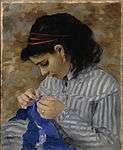 Lise Sewing, 1866, Dallas Museum of Art
Lise Sewing, 1866, Dallas Museum of Art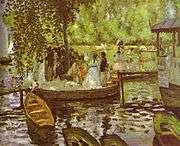 La Grenouillère, 1868, Nationalmuseum, Stockholm
La Grenouillère, 1868, Nationalmuseum, Stockholm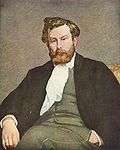 Portrait of Alfred Sisley, 1868
Portrait of Alfred Sisley, 1868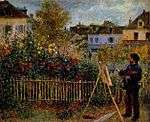
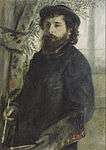 Portrait of Claude Monet, 1875, Musée d'Orsay, Paris, France
Portrait of Claude Monet, 1875, Musée d'Orsay, Paris, France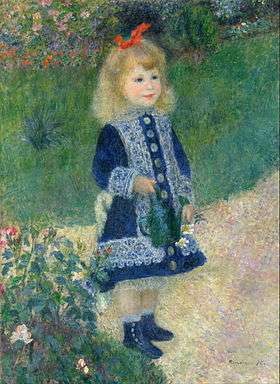 A Girl with a Watering Can, 1876, National Gallery of Art, Washington, D.C.
A Girl with a Watering Can, 1876, National Gallery of Art, Washington, D.C. Mme. Charpentier and her children, 1878, Metropolitan Museum of Art, New York
Mme. Charpentier and her children, 1878, Metropolitan Museum of Art, New York By the Water, 1880, Art Institute of Chicago, Chicago, Illinois
By the Water, 1880, Art Institute of Chicago, Chicago, Illinois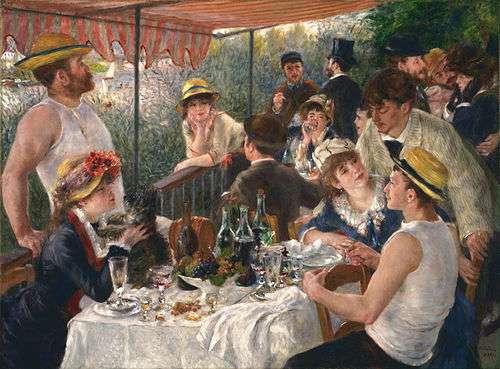 Luncheon of the Boating Party, 1880–1881, The Phillips Collection, Washington, D.C.
Luncheon of the Boating Party, 1880–1881, The Phillips Collection, Washington, D.C.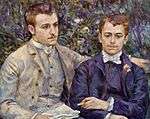 Portrait of Charles and Georges Durand-Ruel, 1882
Portrait of Charles and Georges Durand-Ruel, 1882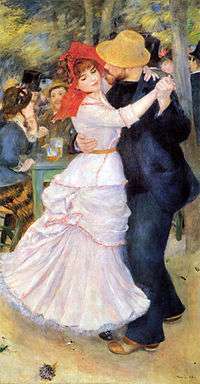 Dance at Bougival, 1882–1883, (woman at left is painter Suzanne Valadon), Boston Museum of Fine Arts
Dance at Bougival, 1882–1883, (woman at left is painter Suzanne Valadon), Boston Museum of Fine Arts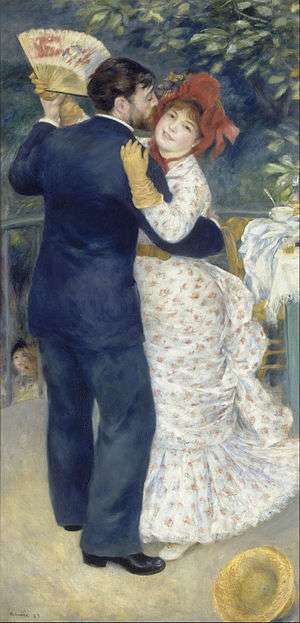 Dance in the Country (Aline Charigot and Paul Lhote), 1883, Musée d'Orsay, Paris
Dance in the Country (Aline Charigot and Paul Lhote), 1883, Musée d'Orsay, Paris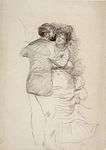 Pencil study for Dance in the Country, 1883, Honolulu Museum of Art
Pencil study for Dance in the Country, 1883, Honolulu Museum of Art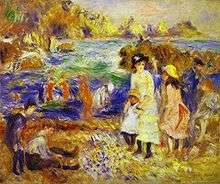 Children at the Beach at Guernsey, 1883, Barnes Foundation, Philadelphia
Children at the Beach at Guernsey, 1883, Barnes Foundation, Philadelphia Pierre-Auguste Renoir, "Jeune garçon sur la plage d'Yport", 1883, Barnes Foundation, Philadelphia
Pierre-Auguste Renoir, "Jeune garçon sur la plage d'Yport", 1883, Barnes Foundation, Philadelphia- Girl With a Hoop, 1885, National Gallery of Art, Washington, D.C.
 Girl Braiding Her Hair (Suzanne Valadon), 1885
Girl Braiding Her Hair (Suzanne Valadon), 1885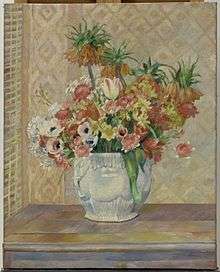 Still Life: Flowers, 1885, Solomon R. Guggenheim Museum, New York
Still Life: Flowers, 1885, Solomon R. Guggenheim Museum, New York Julie Manet with cat, 1887
Julie Manet with cat, 1887 Portrait of Berthe Morisot and daughter Julie Manet, 1894
Portrait of Berthe Morisot and daughter Julie Manet, 1894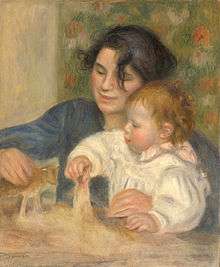 Gabrielle Renard and infant son Jean Renoir, 1895
Gabrielle Renard and infant son Jean Renoir, 1895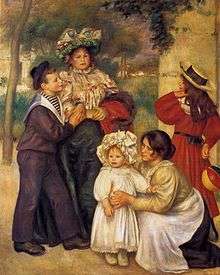 The Artist's Family, 1896, The Barnes Foundation, Philadelphia
The Artist's Family, 1896, The Barnes Foundation, Philadelphia Portrait of Ambroise Vollard, 1908
Portrait of Ambroise Vollard, 1908 Portrait of Paul Durand-Ruel, 1910
Portrait of Paul Durand-Ruel, 1910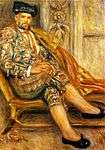 Portrait of Ambroise Vollard, 1917
Portrait of Ambroise Vollard, 1917
Self-portraits
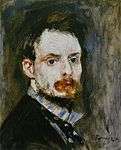 Self-portrait, 1875
Self-portrait, 1875.jpg) Self-portrait, 1876
Self-portrait, 1876 Self-portrait, 1910
Self-portrait, 1910- Self-portrait, 1910
Nudes
 Diana the Huntress, 1867, The National Gallery of Art, Washington, DC
Diana the Huntress, 1867, The National Gallery of Art, Washington, DC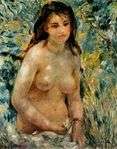 Nude in the Sun, 1875, Musée d'Orsay, Paris
Nude in the Sun, 1875, Musée d'Orsay, Paris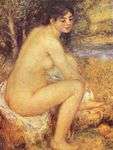 Seated Girl, 1883
Seated Girl, 1883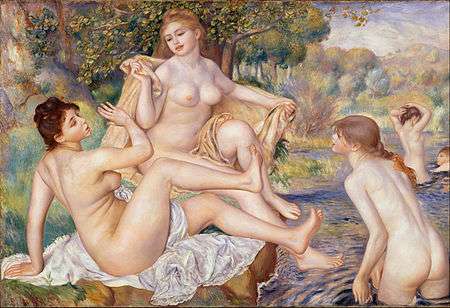
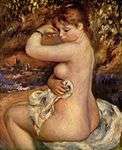 After The Bath, 1888
After The Bath, 1888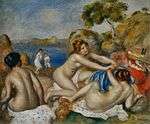 Three Bathers, 1895, Cleveland Museum of Art Cleveland, Ohio
Three Bathers, 1895, Cleveland Museum of Art Cleveland, Ohio Nude, National Museum of Serbia, Belgrade
Nude, National Museum of Serbia, Belgrade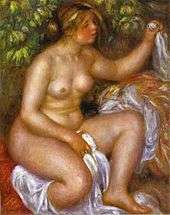 After The Bath, 1910, Barnes Foundation, Philadelphia
After The Bath, 1910, Barnes Foundation, Philadelphia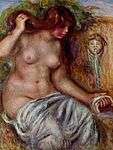 Woman at the Well, 1910
Woman at the Well, 1910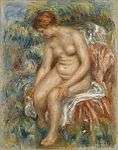 Seated Bather Drying Her Leg, 1914, Musée de l'Orangerie, Paris
Seated Bather Drying Her Leg, 1914, Musée de l'Orangerie, Paris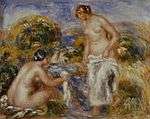 Women Bathers, 1916, National Museum, Stockholm
Women Bathers, 1916, National Museum, Stockholm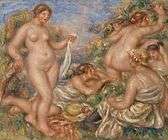 Bathers, 1918, Barnes Foundation, Philadelphia
Bathers, 1918, Barnes Foundation, Philadelphia
Interactive image

Close-ups
See also
References
- ↑ Read, Herbert: The Meaning of Art, page 127. Faber, 1931.
- ↑ Renoir, Jean: Renoir, My Father, pages 57–67. Collins, 1962.
- 1 2 Jennings, Guy (2003). History & Techniques of the Great Masters: Renoir. London: Quantum Publishing Ltd. p. 6. ISBN 1861604696.
- ↑ Vollard, Ambroise: Renoir, An Intimate Record, pages 24–29. Knopf, 1925.
- ↑ Vollard, page 30.
- 1 2 3 Distel, Anne. "Renoir, Auguste." Grove Art Online. Oxford Art Online. Oxford University Press. Web. 27 December 2014.
- ↑ Wadley, Nicholas: Renoir, A Retrospective, page 15. Park Lane, 1989.
- ↑ Renoir, Jean, pages 118–21. Different and less life-threatening versions are offered by Paul Valéry and Vollard. In all accounts, however, their re-acquaintance led to great celebration.
- 1 2 Wadley, page 15.
- ↑ Haine, Scott. The History of France (1st ed.). Greenwood Press. p. 112. ISBN 0-313-30328-2. Check date values in:
|access-date=(help); - 1 2 Brodskaja, Natalja (2010). Impressionism. London: Parkstone Press. p. 114. ISBN 9781844847433.
- ↑ Poulet, A. L., & Murphy, A. R. (1979). Corot to Braque: French Paintings from the Museum of Fine Arts, Boston, page 117. Boston: The Museum. ISBN 0-87846-134-5.
- 1 2 Wadley, page 25.
- ↑ Wadley, pages 371, 374.
- ↑ Wadley, page 28.
- ↑ André, Albert: Renoir. Crés, 1928.
- 1 2 3 "Boonen, A.; van de Rest, J.; Dequeker, J.; van der Linden, S.: "How Renoir Coped with Rheumatoid Arthritis". ''British Medical Journal'', 1997:315:1704–1708". Bmj.com. Retrieved 7 April 2012.
- ↑ Rey, Robert: La Peinture française à la fin du XIXe siècle, la renaissance du sentiment classique : Degas, Renoir, Cézanne, Gauguin, Seurat, Les Beaux-Arts, Van Oest, 1931 (thesis).
- ↑ "From the Tour: Mary Cassatt", August Renoir. Retrieved 7 March 2007.
- ↑ Clark, Kenneth: The Nude, pages 154–61. Penguin, 1960.
- ↑ Asked late in life if he felt an affinity to Ingres, he responded: "I should very much like to". Rey, quoted in Wadley, page 336.
- ↑ "For me, Renoir becomes a really great artist in the late nudes, above all in Les Grandes Baigneuses". David Sylvester, quoted by Wadley, page 378
- ↑ Bernheim-Jeune
- ↑ Wildenstein Institute
Further reading
|
| |
|
|
- Claude Roger-Marx (1952). Les Lithographies de Renoir. Monte-Carlo: Andre Sauret.
- Joseph G. Stella (1975). The Graphic Work of Renoir: Catalogue Raisonne. London: Lund Humphries.
- Jean Leymarie et Michel Melot (1971). Les Gravures Des Impressionistes, Manet, Pissarro, Renoir, Cezanne, Sisley. Paris: Arts et Metiers Graphiques.
- Kang, Cindy. “Auguste Renoir (1841–1919).” In Heilbrunn Timeline of Art History. New York: The Metropolitan Museum of Art, 2000–. (May 2011)
- Michel Melot (1996). The Impressionist Print. New Haven: Yale University Press.
- Theodore Duret (1924). Renoir. Paris: Bernheim-Jeune.
- Paul Haeserts (1947). Renoir Sculpteur. Bruxelles: Hermès.
External links
| Wikimedia Commons has media related to: |
| Wikiquote has quotations related to: Pierre-Auguste Renoir |
- Works by or about Pierre-Auguste Renoir at Internet Archive
- Gallery of works
- Suburban Pastoral, The Guardian, 24 February 2007
- Avant-Gardist in Retreat, Holland Cotter, The New York Times, 17 June 2010
- Timeline of French Artists
- Pierre-Auguste Renoir at Find a Grave
- Impressionism: a centenary exhibition, an exhibition catalog from The Metropolitan Museum of Art (fully available online as PDF), which contains material on Renoir (p. 179–200)
 "Renoir, Firmin Auguste". Encyclopædia Britannica (11th ed.). 1911.
"Renoir, Firmin Auguste". Encyclopædia Britannica (11th ed.). 1911.- Pierre-Auguste Renoir in American public collections, on the French Sculpture Census website

.jpg)
.jpg)
.jpg)
.jpg)
.jpg)
.jpg)
.jpg)
.jpg)
.jpg)
.jpg)
.jpg)
.jpg)
.jpg)
